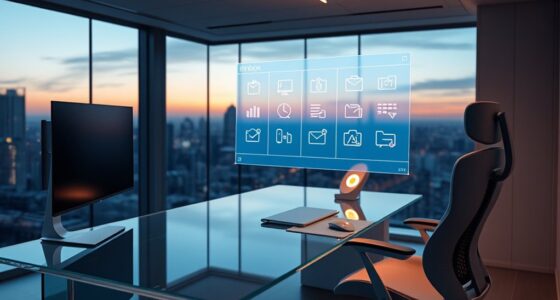Using dark mode helps reduce blue light exposure and minimizes eye strain, which can support your body’s melatonin production. Less blue light at night allows your circadian rhythm to stay in sync and makes it easier for you to fall asleep naturally. Additionally, darker screens decrease glare, creating a more relaxing environment before bed. Keep exploring to discover simple tips that can boost your sleep quality even further and enhance your nightly routine.
Key Takeaways
- Dark mode reduces blue light exposure, promoting melatonin production and supporting natural sleep cycles.
- It minimizes screen glare and brightness, decreasing eye strain and visual discomfort during nighttime use.
- Using dark mode helps prevent circadian disruption caused by high-intensity, blue-rich screen light.
- It encourages healthier pre-sleep routines by creating a relaxing, low-light environment.
- Incorporating dark mode along with good sleep habits can enhance sleep quality and overall circadian rhythm health.
Understanding the Impact of Blue Light on Sleep
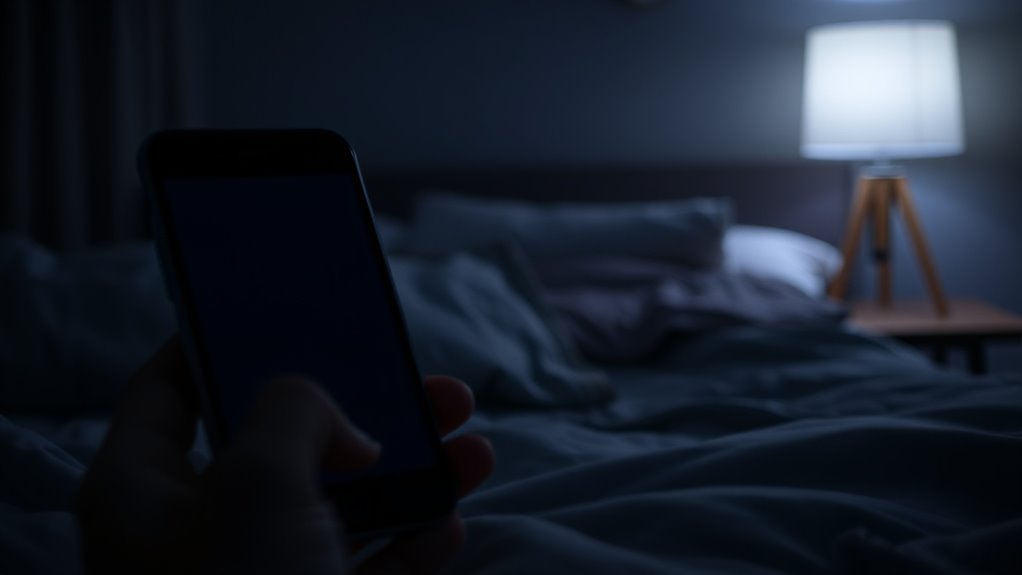
Since blue light exposure can interfere with your sleep, understanding its impact is essential. When you look at screens, you might notice flickering or color shifts caused by changes in screen flicker and color temperature. Blue light, which has a high energy level, suppresses melatonin production, making it harder for you to fall asleep. Modern screens often adjust their color temperature to emit cooler, blue-rich light during the day, which can delay your sleep cycle. Even subtle screen flicker can cause eye strain and disrupt your circadian rhythm. Recognizing how these factors affect your sleep helps you make better choices about device use, especially before bedtime. Additionally, some screens employ flicker reduction technology to minimize eye strain and improve visual comfort. Implementing blue light filters can significantly decrease exposure and promote more restful sleep. Reducing your blue light exposure can promote more restful sleep and improve overall health, especially when paired with light management strategies such as dimming screens or using blue light filters. Being aware of screen flicker can further help you minimize eye strain and improve your visual comfort during prolonged device use.
How Dark Mode Reduces Blue Light Exposure
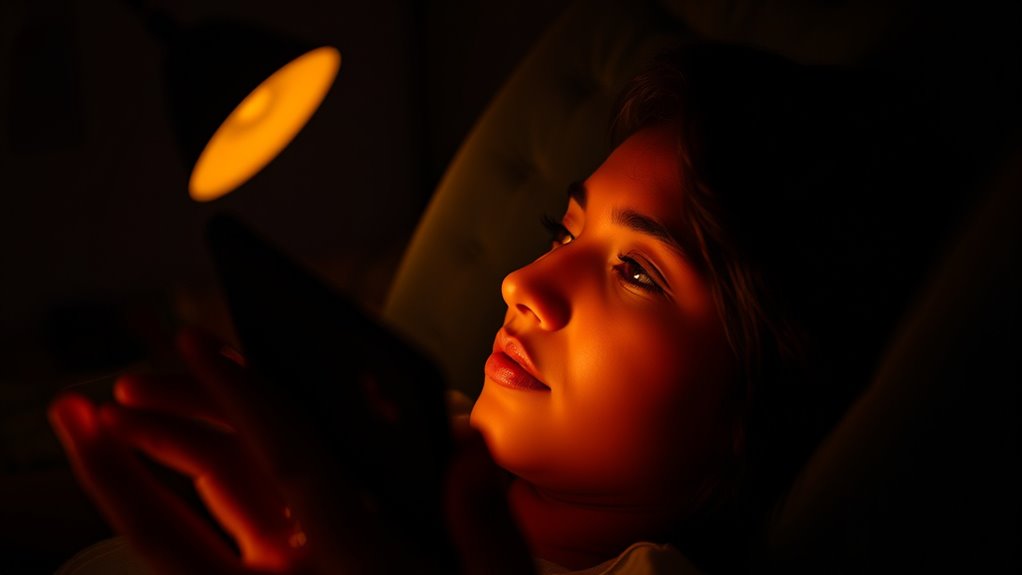
Switching to dark mode can substantially cut down your blue light exposure, especially during evening hours. Dark mode adjusts your screen’s display color, shifting from bright, blue-heavy light to darker, warmer tones. This change improves screen calibration by reducing the blue light emitted, which is known to interfere with melatonin production. By lowering blue light levels, you’ll experience less eye strain and a decreased impact on your sleep cycle. Many devices automatically optimize display color in dark mode, making it easier to relax before bed. This simple switch helps limit your exposure to the harmful wavelengths that can delay sleep onset. Additionally, understanding how to manage appliance power consumption can contribute to overall healthier habits by reducing unnecessary screen time and energy use. Incorporating features like screen brightness adjustment can further enhance sleep quality by controlling light intensity. Adjusting your device settings to enable blue light filters can provide an extra layer of protection against sleep-disrupting wavelengths. Using the right display settings can also help minimize eye strain and promote better rest. Overall, reducing blue light through dark mode supports healthier sleep patterns and promotes better rest.
The Connection Between Screen Brightness and Melatonin Production

Bright screens can profoundly suppress melatonin production, the hormone responsible for regulating your sleep-wake cycle. When your screen’s brightness is high, it emits intense light that signals your brain to stay alert, delaying melatonin release. This melatonin suppression can make falling asleep more difficult and reduce sleep quality overall. Even if blue light is minimized, excessive screen brightness alone can disrupt your natural circadian rhythm. Adjusting your device’s brightness to a lower level helps reduce this suppression, allowing melatonin levels to rise naturally as evening approaches. Screen brightness levels play a crucial role in how much light exposure affects your sleep hormones. By managing screen brightness, you support your body’s ability to produce enough melatonin for restful sleep, making it easier to fall asleep and stay asleep throughout the night. Additionally, incorporating dark mode settings on devices can further minimize light exposure and improve evening relaxation. Proper light exposure management is essential for maintaining a healthy sleep cycle. Moreover, understanding the impact of artificial light on your circadian rhythm can help you make more informed choices about your evening device use.
Benefits of Using Dark Mode Before Bedtime
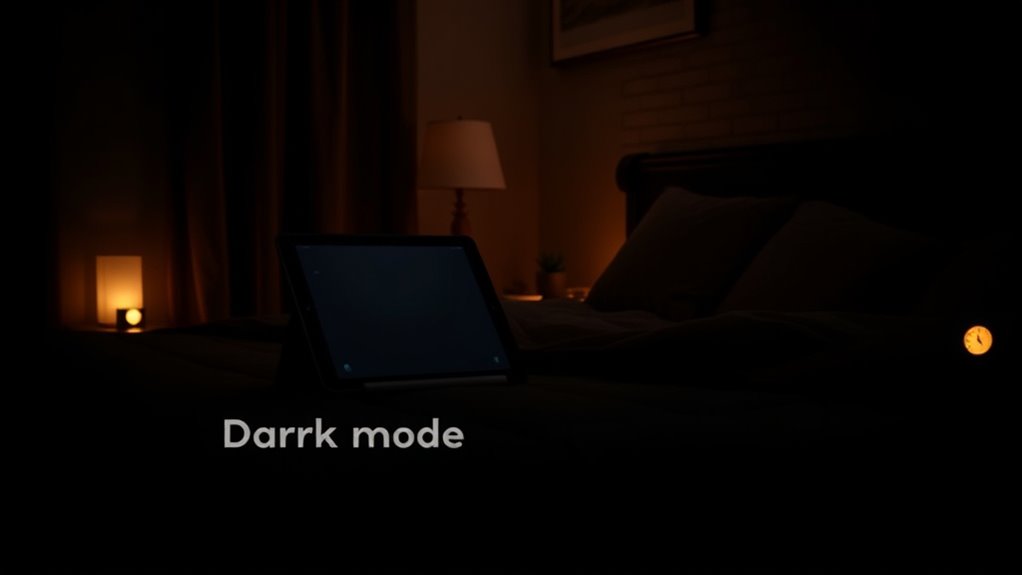
Using dark mode before bed can help reduce eye strain, making it easier to wind down. It also supports melatonin production, which is essential for quality sleep. Switching to dark mode now might be a simple step toward better rest. Additionally, avoiding bright screens can minimize the risk of disrupting your sleep patterns, aligning with research on AI safety measures and their importance in maintaining optimal functioning. Recognizing recurring angel numbers can serve as subtle signs encouraging relaxation and mindfulness, further promoting restful sleep. Incorporating emotional regulation techniques can also enhance your ability to relax before sleep, leading to more restorative rest. Understanding ethical hacking principles highlights the importance of protecting personal data, which can contribute to peace of mind and better sleep quality.
Reduces Eye Strain
Have you noticed that your eyes feel less tired when you opt for dark mode before bed? Adjusting your display settings to dark mode can markedly enhance eye comfort, especially during nighttime use. Bright screens with white backgrounds strain your eyes, causing discomfort and fatigue. Dark mode reduces glare and minimizes the amount of blue light hitting your eyes, making it easier to focus without squinting or feeling overwhelmed. By lowering the overall brightness, you decrease eye strain and prevent headaches caused by prolonged screen time. Proper screen placement also plays a role in reducing eye fatigue, ensuring your device is positioned at an optimal viewing angle. Additionally, the use of eSIM technology with enhanced security features can help protect your data if you experience device issues during late-night use. This simple change helps your eyes relax and stay comfortable, even after hours of use. Switching to dark mode before bed isn’t just easier on your eyes—it also sets the stage for a more restful night.
Promotes Melatonin Production
Since exposure to blue light can suppress melatonin production, switching to dark mode before bed allows your body to naturally increase its melatonin levels. This supports better sleep hygiene by aligning your habits with your circadian rhythms, which regulate your sleep-wake cycle. When you reduce blue light exposure, your brain recognizes it’s nighttime, prompting melatonin release. Dark mode minimizes light interference, helping you maintain the natural rhythm of your body. This promotes a more restful sleep and easier shift into deep sleep stages. Consistently using dark mode in the evening can reinforce healthy sleep patterns, making it easier to fall asleep and improve overall sleep quality. Prioritizing this simple change can markedly enhance your sleep hygiene and circadian harmony.
Tips for Switching to Dark Mode Effectively
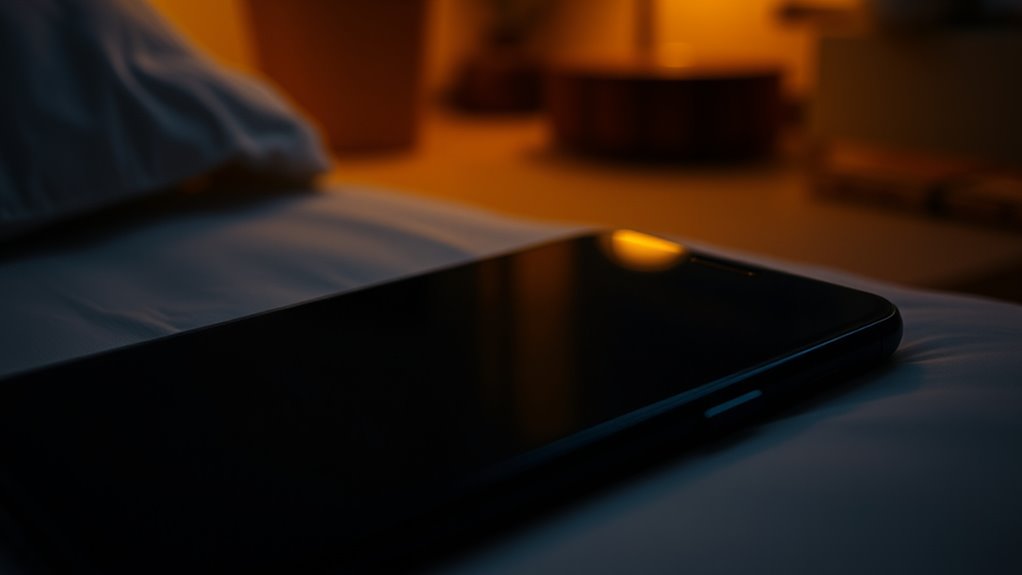
Switching to dark mode can be a smooth process if you approach it thoughtfully. First, confirm your screen is properly calibrated; accurate brightness and contrast settings will prevent eye strain and make the transition easier. Adjust the display so it’s comfortable in your typical ambient lighting conditions. Avoid shifting to dark mode in overly bright environments, as this can cause discomfort. Instead, switch when your room lighting is moderate or dim to allow your eyes to adjust gradually. Take small steps—try dark mode for short periods before making it permanent. This helps your eyes adapt without feeling overwhelmed. Remember, a consistent environment and proper calibration create a seamless switch, making dark mode more enjoyable and beneficial for your sleep health.
Additional Habits to Improve Sleep Quality

Implementing additional habits can markedly enhance your sleep quality beyond just adjusting your environment. Good sleep hygiene is essential, and incorporating relaxation techniques can help you wind down more effectively. Establish a consistent sleep schedule, going to bed and waking up at the same time daily. Avoid screens and caffeine before bed, and create a calming pre-sleep routine. Use relaxation techniques like deep breathing, meditation, or gentle stretches to ease your mind and body. These practices reduce stress and improve sleep onset. Remember, consistency is key for long-term benefits. By combining these habits with dark mode adjustments, you’ll support better sleep hygiene and enjoy more restorative rest.
- Maintain a regular sleep schedule
- Limit screen time before bed
- Practice deep breathing or meditation
- Create a calming bedtime routine
- Avoid caffeine and heavy meals near bedtime
Potential Limitations of Dark Mode for Sleep Improvement
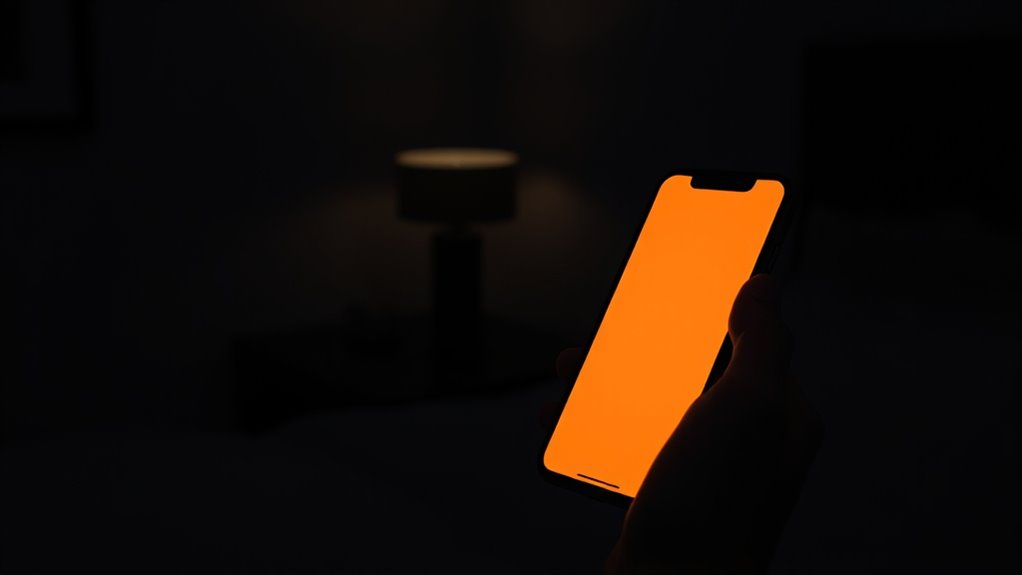
While dark mode can reduce screen brightness and minimize blue light exposure, it doesn’t guarantee better sleep for everyone. For some, screen glare remains a problem, especially if the app or website isn’t optimized for dark mode, causing eye strain and discomfort. Additionally, relying heavily on dark mode might increase device dependency, making it harder to disconnect from screens altogether. If you become too accustomed to dark environments, you may overlook other factors that influence sleep, like overall screen time or content engagement. Dark mode isn’t a cure-all; it’s just one piece of the puzzle. If your sleep issues persist, addressing habits beyond screen settings is essential for meaningful improvements.
Long-Term Benefits of Incorporating Dark Mode Into Your Night Routine
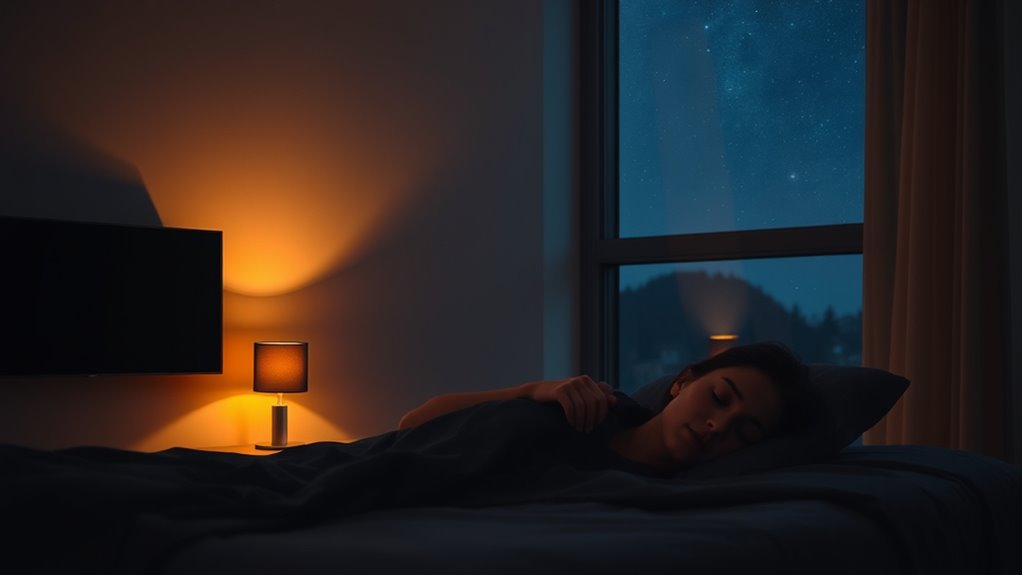
By making dark mode a regular part of your night routine, you may boost your melatonin levels, helping you fall asleep faster. It can also reduce eye strain, making your evening activities more comfortable. Over time, these benefits can support better sleep quality and overall health.
Enhanced Melatonin Production
Switching to dark mode in your nightly routine can considerably boost melatonin production, the hormone responsible for regulating sleep. Melatonin aligns with your circadian rhythms, signaling your body it’s time to wind down. By reducing exposure to blue light, dark mode supports natural hormone release, similar to light therapy but more targeted for evening use. Consistent use helps your body adapt, improving sleep quality over time. This enhanced melatonin production not only helps you fall asleep faster but also promotes deeper, restorative sleep cycles. Incorporating dark mode encourages your circadian rhythms to stay synchronized, preventing disruptions caused by artificial light. Over the long term, this practice helps maintain a healthy sleep-wake cycle, making restful sleep a natural, effortless part of your nightly routine.
- Supports natural hormone regulation
- Reinforces circadian rhythm alignment
- Mimics effects of light therapy
- Promotes deeper sleep cycles
- Reduces sleep disruptions
Reduced Eye Strain
Incorporating dark mode into your nightly routine not only enhances melatonin production but also substantially reduces eye strain over time. By minimizing screen glare, dark mode lessens the stress on your eyes, making it easier to focus and reducing fatigue during prolonged use. This improved visual comfort helps prevent headaches and eye discomfort often caused by bright screens. Over the long term, reducing eye strain can lead to fewer issues related to digital eye strain, such as dryness or blurred vision. Switching to dark mode creates a more soothing viewing experience, especially in low-light environments, which helps your eyes relax and recover after a busy day. Ultimately, this small change supports healthier eyes and a more comfortable digital experience during your night routine.
Frequently Asked Questions
Can Dark Mode Reduce Eye Strain During Nighttime Screen Use?
Using dark mode can definitely help reduce eye strain during nighttime screen use. It minimizes blue light exposure, which is known to cause eye fatigue and disrupt your sleep cycle. When you switch to dark mode, your eyes find it easier to focus, especially in low-light conditions. This simple change can make a big difference by easing eye fatigue and making nighttime screen time more comfortable.
Does Dark Mode Affect the Visibility of Important Notifications?
Dark mode can influence notification visibility, especially in low-light settings. While it reduces glare and eye strain, it might make alerts less noticeable if the contrast isn’t well-designed. You may find that your alert responsiveness decreases if important notifications blend into the background. To balance this, customize notification colors or use brighter highlights for critical alerts, ensuring you don’t miss essential updates while enjoying the benefits of dark mode.
Are There Specific Apps That Work Better With Dark Mode for Sleep?
Some apps work better with dark mode, especially those with high app compatibility for your device. You might find that messaging or social media apps, like WhatsApp or Instagram, are easier on your eyes at night. Your user preferences also matter—if you prefer darker screens, you’ll likely enjoy these apps more. Choosing apps that support dark mode helps reduce eye strain and creates a more comfortable viewing experience before sleep.
Can Switching to Dark Mode Improve Overall Sleep Duration?
Balancing bedtime benefits begins by considering your screen habits. Switching to dark mode reduces blue light exposure, which can hinder melatonin production, making it harder to fall asleep. By dimming display brightness and adopting dark mode, you help your body produce melatonin naturally, potentially extending sleep duration. You’ll find that less blue light leads to longer, more restful nights, helping you wake up feeling refreshed and ready for the day.
How Does Dark Mode Compare to Other Sleep-Friendly Screen Settings?
Compared to other sleep-friendly screen settings, dark mode often offers a lower color temperature and reduced screen brightness, making it gentler on your eyes. While options like blue light filters or night mode adjust color temperature, dark mode primarily minimizes bright backgrounds and harsh contrasts. You’ll find it easier to relax before bed, as it decreases eye strain and limits stimulating light, helping you fall asleep faster and enjoy better sleep quality.
Conclusion
Switching to dark mode is like giving your sleep a gentle night’s kiss, helping your body produce melatonin naturally. By reducing blue light exposure, you set the stage for restful nights and energized mornings. While dark mode isn’t a magic fix, it’s a simple step toward better sleep habits. Embrace this change and watch how your nights transform from restless storms to peaceful dreams, guiding you to wake up refreshed and ready.


